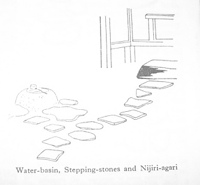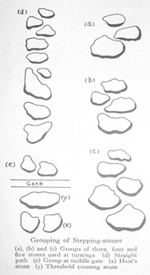TREES AND SHRUBS
庭の木々
The planting of trees in a Tea-garden should be such as to suggest some quiet spot in the woods where all the fresh purity of nature abides in an air of solitary detachment.
茶室の庭にある木々、それは森の中の静寂の一場面として存在します。ここは世俗を離れた空気が漂い自然に満ちた新鮮な場所です。
But the plantation must not be thick enough to produce any feeling of stuffiness or restraint. There should be sufficient trees and shrubs to give an impression of depth, but all must be quite natural, and rare or peculiar specimens or those that bear bright flowers should be omitted.
息苦しさを感じたり、風通しの悪い密集した植え方はダメです。木々には奥ゆかしさがあり自然に、派手な花々は避けられていて独特の世界観が作られています。
* It is perhaps hardly necessary to emphasize the Japanese preference for black-and-white, or rather the varying shades of black, to color. Just as in music their taste is for the simple and unsophisticated, so in decoration their most favored hues are ask color, tea color and mouse color, though there are a very great number of shades of these.
* 花が避けられているのは、たぶん、白黒を強調するために必要なことだと考えられます。彼ら日本人にはさまざまな陰の色があって、例えば音楽もそうですが高度なものではなく起伏のすくないシンプルなものです。装飾においてももっとも好む色は灰色で、茶色やねずみ色なども使用します。陰を表現するのにとてもよいのだと思われます。
It is best to have only those that are common in the neighborhood.
近隣においてもこの価値観は共通です。

Three trees of the same shapes standing in a row are to be avoided, as are trees exactly opposite each other or one behind the other.
木の後へ植えたり向かい合わせて並べたり、三本同じような形のものを並べたりするのは避けられています。
Neither must one be placed exactly facing the entrance to the inner Roji as one enters, or opposite the water basin.
内露地入り口へ向う場所や蹲(つくばい)に向かい合った場所もいけません。
Trees and shrubs that grow in the mountains are most suitable, and they should not be chosen particularly for their shape as in a more formal garden but planted naturally as they grow, and the leaves be allowed to lie on the ground beneath them as in the forest.
庭木は山で育ったものが最も好まれ、そしてその姿は庭園にあるようなものは選ばれません。自然に育ったように演出され地面には葉が敷かれ森の様子を表しています。
To vary the effect and prevent monotony deciduous trees such as the different varieties of Maple and Oak, Willow, Mimosa, Melia Japonica, etc. may be planted, but a Tea-garden must never be without evergreens, and the Pine Cypress, Crytomeria, Ilex, Palmyrapalm, Tamarix Chinesis, Viburnum, Aucuba, Tatsia Japonica, Cercidiphyllum and Japonicum, and Aegle Sepiaria with firs and bamboos are the most suitable.
変化をもたせ単調さを避けるため紅葉や樫をはじめ多くの木が落葉性の木が植えられます。
Bright-colored trees such as the Wistaria, Clove, Pyrus Spectabilis, Camellia, Tea-tree, Magnolia, Cucumber and Orange are out of place in a Roji.
派手な花をつける木は路地では避けられます。
* Furuta Oribe wasthe first to plant Fir trees in the Roji. Till then Pines and bamboo with grass or Eleagnus Pungens underneath was the rule.
* 古田織部がモミの木を露地に始めて植えました。それまでは松や竹で地面は苔などが決まり事でした。
It is because of their high regard for flowers that chajin do not care for flowering trees or any blossom in the Roji.
露地に花の咲く木や花がないのは茶人はそれだけ花に対して気を配ると言うことです。
For these would catch the eye before entering the Tea-room and the mind might be distracted and exercised by comparisons so that it would not be easy to maintain that quiet concentration on the flower in the Tokonoma that Tea taste requires.
茶の湯において茶室床の間に活けられた花にその気を集中させることが第一です。茶室に入る前に花が目にはいると注意をそらせるという理論になって、または、その集中力の訓練の意味もあるのかもしれません。
The exception in the cherry tree, which may be permitted, though not exactly recommended.
例外として桜の木があります。多分推奨まではいかないけれども許可されていたのかもしれません。
Where there is one the host may invite guests when it is in blossom, and then a picture flower arrangement, or empty flower vase may be put there and beside it a flower tray with a pair of scissors on it.
花の咲く季節に亭主が客を招待し、床には花をあしらった絵がかけてあったり、花入れと花盆の上にハサミをおいておくという趣向をしたりしています。
This is sufficient to suggest the presence of the Queen of flowers in the Tea-room while she holds her brief court outside.
それはまさに女王がブリーフコートをもち、これから茶室へ向かうその一瞬の場面なのです。
Rikyu held that a Tea-garden should be arranged with the tallest trees in the foreground and the lower in the background, but Furuta Oribe preferred the reverse, while Sen Dotan thought the ideal Roji a very small neat garden broadening out into a landscape of unlimited extent toward distant hills.
利休は高い木は前景へ低い木は後景へ植えるのが良いとし、古田織部はその反対を推奨しました。千道安は、露地の景色とは小さくてこぎれいな庭が遥かなる丘へ向かって無限に広がっていくようでなければならないと考えました。
It is well to keep in mind the principle laid down by Katagiri Sekishu in this as in all other matter concering Cha-no-yu that the best taste lies in not showing it, and that a house or garden should be made not with the intention of showing the taste of the owner, but because it is fit for its purpose. Conscious estheticism as always bad.
この考え方は片桐石州によって継承され、茶の湯に関係するものはすべてあてはめられました。庭や家にたいするオーナーの好みは排除され、一つの価値基準だけが作られて行きます。感性ではなく意識的な美は常によくありません。
* There is a good story to the effect that a certain host who was very proud of his house and furnishings said to his guest, "As you see, my things are of no consequence at all, so if you think there is anything that does not harmonies, just say so and I will take it away at once." "Well," replied the guest, who happened to be a plain-spoken fellow, "I find no fault at all with the furnishings, the only improvement I can think of would be your own absence." It may be instructive to compare this with the anecdote of Castruccio Castracane, Lord of Lucca, quoted by Machiavelli, which relates how that warrior being invited to supper, by Taddeo Bernardi, a very rich and splendid citizen of Lucca, he went to the house and was shown by Taddeo into a chamber hung with silk and paved with fine stones representing flowers and foliage of the most beautiful colouring. Castruccio gathered some saliva in his mouth and spat it out on Taddeo, and seeing him disturbed at this, said to him, "I knew not where to spit in order to offend thee less." The difference between European and Japanese civilization here seems to be one of words and spit rather than of "clouds and mud."
ここに一つの話があります。家や家具など上等なものを持つお金持ちの人がいました。ある時、彼が亭主となり茶事を催しました。客に対して道具などを見せ、「どうですか?趣向などに間違いなどありましたらすぐにこのような道具は処分しますよ」と傲慢に言います。すると客の一人が返します「完璧で言うことありません、ただ、恐縮ですが、一つだけ改良するとすれば、それは貴殿の茶がありませんね」。この話は多分、我々の耳にするイタリアの政治家で目的の為には手段を選ばすで有名なアキアベリのCastruccio Castracaneのたとえ話と対比できると思います。武人がお金持ちの晩餐へ行き、贅沢な部屋などを見せられて唾をはき亭主を侮辱します。ヨーロッパと日本では言葉と唾、雲と泥ほどの違いがあります。

The sweeping and cleaning of the Roji must not be overdone, though it should not, of course, be at all neglected.
露地のお掃除はやりすぎてはいけません、もちろん、まったくやらないというのはダメです。とても微妙です。
The ideal to be aimed at is that it should be naturally clean like a forest glade, but not aggressively neat.
森の中の自然な美しさで整理整頓ではありません。
Therefore the Tea masters considered that a boy or an old man, or at least someone other than the owner was best entrusted with the task, because they would not be too painstaking.
したがって、茶人達は少年や老人の様なひとにその作業を委ねます。あまり丹精込めた完璧な仕事をしないようにです。
Leaves that have been blown about under the trees and between the stones look interesting and should not be disturbed.
敷石や落葉の風情はとても素晴らしいのです。
Rikyu laid it down that the Roji should be swept overnight for a morning Cha-no-yu, and in the morning for one at midday, so that the leaves would have time to fall in the meanwhile.
利休は朝茶事のときは夜が明ける前に、正午の茶事のときは朝に掃除をすることを言いました。その理由は落葉するその時を大切にしたのです。
INTRODUCTION-1 TITLE CONTENTS